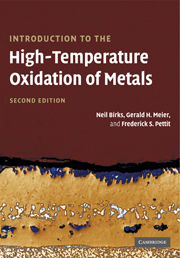Book contents
- Frontmatter
- Contents
- Acknowledgements
- Preface
- Introduction
- 1 Methods of investigation
- 2 Thermodynamic fundamentals
- 3 Mechanisms of oxidation
- 4 Oxidation of pure metals
- 5 Oxidation of alloys
- 6 Oxidation in oxidants other than oxygen
- 7 Reactions of metals in mixed environments
- 8 Hot corrosion
- 9 Erosion–corrosion of metals in oxidizing atmospheres
- 10 Protective coatings
- 11 Atmosphere control for the protection of metals during production processes
- Appendix A Solution to Fick's second law for a semi-infinite solid
- Appendix B Rigorous derivation of the kinetics of internal oxidation
- Appendix C Effects of impurities on oxide defect structures
- Index
- References
6 - Oxidation in oxidants other than oxygen
Published online by Cambridge University Press: 05 June 2012
- Frontmatter
- Contents
- Acknowledgements
- Preface
- Introduction
- 1 Methods of investigation
- 2 Thermodynamic fundamentals
- 3 Mechanisms of oxidation
- 4 Oxidation of pure metals
- 5 Oxidation of alloys
- 6 Oxidation in oxidants other than oxygen
- 7 Reactions of metals in mixed environments
- 8 Hot corrosion
- 9 Erosion–corrosion of metals in oxidizing atmospheres
- 10 Protective coatings
- 11 Atmosphere control for the protection of metals during production processes
- Appendix A Solution to Fick's second law for a semi-infinite solid
- Appendix B Rigorous derivation of the kinetics of internal oxidation
- Appendix C Effects of impurities on oxide defect structures
- Index
- References
Summary
Introduction
Most metals are thermodynamically unstable with respect to many of their compounds, particularly metal halides and sulphides, in addition to oxides. This is reflected in the extensive processing that is required to extract metals from their various ores. This chapter is concerned with the corrosion reactions by which metals return to their stable oxidized state, by reaction with sulphur, carbon, nitrogen, and the halogens. Often the corrosive gases encountered in practice contain oxygen, as well as one of these components. This problem of ‘mixed-oxidant corrosion’ will be addressed in the next chapter.
Reactions with sulphur
Metals react readily with sulphur, by mechanisms that parallel those involved in reactions with oxygen. The sulphides of iron and nickel show metallic conduction, i.e., they have high electrical conductivities, which decrease with increasing temperature and are nearly independent of sulphur partial pressure and stoichiometry (H. J. Grabke, personal communication). The departure from stoichiometry in sulphides is generally greater than in the case of oxides, diffusion is faster in sulphides, which are also more plastic than the corresponding oxides and generally have lower melting points. In particular, low-melting metal-sulphide eutectics are common.
Compared with oxidation, the sulphidation of a metal proceeds more rapidly and can be studied at lower temperatures and over shorter times. Sulphide scales tend to be quite plastic but their adherence is not good because most grow by outward cation diffusion and form voids at the scale–metal interface.
Information
- Type
- Chapter
- Information
- Introduction to the High Temperature Oxidation of Metals , pp. 163 - 175Publisher: Cambridge University PressPrint publication year: 2006
References
Accessibility standard: Unknown
Why this information is here
This section outlines the accessibility features of this content - including support for screen readers, full keyboard navigation and high-contrast display options. This may not be relevant for you.Accessibility Information
- 2
- Cited by
